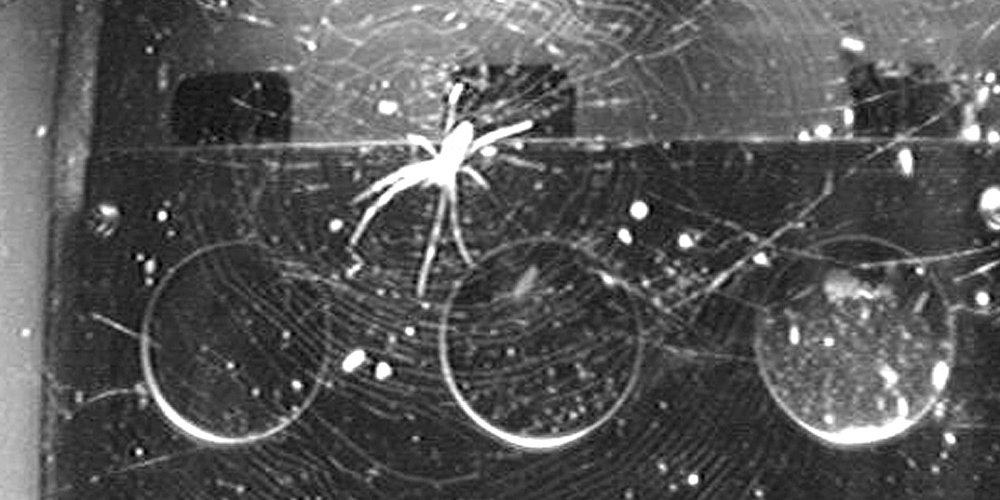Spiders in Space: Light as a Substitute for Gravity
The University of Basel has just issued a very nice story in a press release. It’s about spiders, and the following is probably only great for those who like the useful animals at least a little bit. But let the (translated) press release have its say.
On earth, spiders form asymmetrical webs, whose center is shifted towards the upper edge. In resting state the spiders sit upside down, because they can move faster in the direction of gravity towards freshly caught prey. But what do arachnids do in zero gravity? In 2008, NASA wanted to get high schools in the USA excited about this experiment. But although the question was simple, the planning and execution of the experiment in space was extremely demanding. This led to a series of mishaps.
Two specimens of different spider species flew as “spidonauts” to the International Space Station (ISS), one (Metepeira labyrinthea) as the main one and the other (Larinioides patagiatus) as a reserve in case the first one did not survive. Breakdown 1: The reserve spider managed to break out of its storage chamber and enter the main chamber. The chamber could not be opened for safety reasons, so that the reserve spider could not be recaptured. The two spiders stretched somewhat tangled webs and got in each other’s way. Breakdown 2: And as if that wasn’t enough, the flies that were trapped for food multiplied faster than expected. Over time, their larvae crawled out of the breeding box on the bottom of the crate and into the experimental chamber, covering large parts of the front window after two weeks. After one month, the spiders behind all the fly larvae could no longer be seen.
This failure nagged Paula Cushing of the Denver Museum of Nature & Science, who was involved in the planning of the spider experiment, for a long time. When the opportunity for a similar experiment on board the ISS arose again in 2011, the researcher brought Dr. Samuel Zschokke from the University of Basel on board to prepare and analyze the new experiment. This time the experiment started with four spiders of the same species (Trichonephila clavipes): Two flew to the ISS in separate habitats, two stayed on Earth in separate habitats and were kept and observed under identical conditions as their conspecifics on space travels – only that they were exposed to terrestrial gravity.
The original plan was to use four females. But another mishap occurred, mishap 3: The spiders had to be selected as juveniles for the experiment, and it is extremely difficult to determine the sex of the juveniles. In the course of the experiment it turned out that two of the spiders were males, which in their adult state differ significantly in build and size from the females of this species. But finally there was a stroke of luck – one of the males was on board the space station, the other on earth.
So the arachnids spun their webs, dismantled them and spun new ones. Three cameras took pictures every five minutes. Zschokke, Cushing and Stefanie Countryman from BioServe Space Technologies at the University of Colorado, who monitored the design and launch of the habitats certified for space flight with the spider and fruit fly larvae and the camera system to the International Space Station, analyzed the symmetry of 100 spider webs and the orientation of the spider in the web on the basis of around 14,500 images.
It turned out that the spider webs built in weightlessness were actually more symmetrical than those spun on Earth. Their center was closer to the center, and the spiders did not always keep their heads down. However, the researchers found that it made a difference whether the spiders built their webs under lamplight or in the dark. Webs built in lamplight on the ISS were similarly asymmetrical to terrestrial ones.
“We never thought that light would play a role in the orientation of the spiders in space,” says Zschokke, who analyzed the spider experiment and published the results with his colleagues in the journal Science of Nature. “We were very lucky that the lamps were placed at the top of the chamber and not on different sides. Otherwise we would not have been able to discover the effect of light on the symmetry of the webs in weightlessness”.
Analysis of the images also showed that the spiders rested in their webs in random orientations when the lights were off, but oriented away – i.e. downwards – when the lights were on. It seems that the spiders use the light as an additional orientation aid when gravity is absent. Since spiders can build their webs in the dark and catch prey without light, it was previously assumed that light was not important for their orientation.
“The fact that spiders have a back-up system for such orientation seems surprising, since they have never been exposed to an environment without gravity during their evolution,” says Zschokke. On the other hand, according to Zschokke, a spider’s sense of orientation can get confused while it is building up its web. The organ responsible for this sense registers the relative position of the front part of the body to the rear. During the construction of the web, the two parts of the body are in constant motion, so that an additional orientation aid based on the direction of light is particularly useful.
